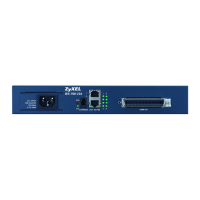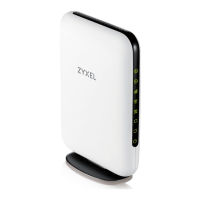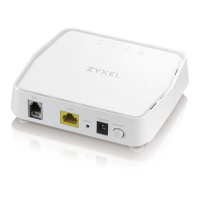Chapter 9 NAT
USG FLEX H Series User’s Guide
153
Incoming Interface Select the interface on which packets for the NAT rule must be received. It can be an
Ethernet, VLAN or bridge interface.
Source IP Specify the source IP address of the packets received by this NAT rule’s specified incoming
interface.
any - Select this to use all of the incoming interface’s IP addresses including dynamic
addresses or those of any virtual interfaces built upon the selected incoming interface.
User Defined - Select this to manually enter an IP address in the User Defined field. For
example, you could enter a static IP address.
Host address - select a address object to use the IP address it specifies.
External IP Specify the destination IP address of the packets received by this NAT rule’s specified
incoming interface. The specified IP address will be translated to the Internal IP address.
any - Select this to use all of the incoming interface’s IP addresses including dynamic
addresses or those of any virtual interfaces built upon the selected incoming interface.
User Defined - Select this to manually enter an IP address in the User Defined field. For
example, you could enter a static public IP assigned by the ISP without having to create a
virtual interface for it.
Host address - select a host address object to use the IP address it specifies. The list also
includes address objects based on interface IPs. So for example you could select an
address object based on a WAN interface even if it has a dynamic IP address.
Internal IP Select to which translated destination IP address this NAT rule forwards packets.
User Defined - this NAT rule supports a specific IP address, specified in the User Defined field.
HOST address - the drop-down box lists all the HOST address objects in the Zyxel Device. If
you select one of them, this NAT rule supports the IP address specified by the address
object.
External IP Subnet/
Range
This field displays for Many 1:1 NAT. Select the destination IP address subnet or IP address
range that this NAT rule supports. The original and mapped IP address subnets or ranges
must have the same number of IP addresses.
Internal IP Subnet/
Range
This field displays for Many 1:1 NAT. Select to which translated destination IP address subnet
or IP address range this NAT rule forwards packets. The original and mapped IP address
subnets or ranges must have the same number of IP addresses.
Port Mapping Type Use the drop-down list box to select how many original destination ports this NAT rule
supports for the selected destination IP address (Original IP). Choices are:
any - this NAT rule supports all the destination ports.
Port - this NAT rule supports one destination port.
Ports - this NAT rule supports a range of destination ports. You might use a range of
destination ports for unknown services or when one server supports more than one service.
Service - this NAT rule supports a service such as FTP (see Object > Service > Service)
service-group - this NAT rule supports a group of services such as all service objects related
to DNS (see Object > Service > Service Group)
Protocol Type This field is available if Mapping Type is Port or Ports. Select the protocol (TCP, UDP, or Any)
used by the service requesting the connection.
External Port This field is available if Mapping Type is Port. Enter the external destination port this NAT rule
supports.
Internal Port This field is available if Mapping Type is Port. Enter the translated destination port if this NAT
rule forwards the packet.
External Start Port This field is available if Mapping Type is Ports. Enter the beginning of the range of original
destination ports this NAT rule supports.
Table 80 Network > NAT > Add (continued)
LABEL DESCRIPTION

